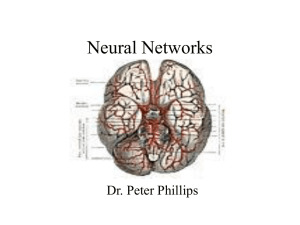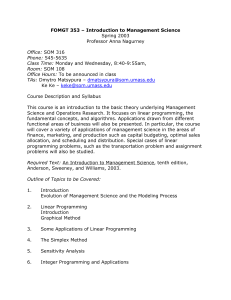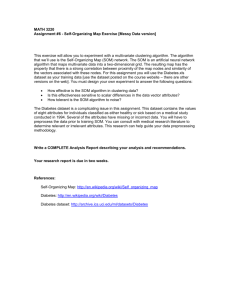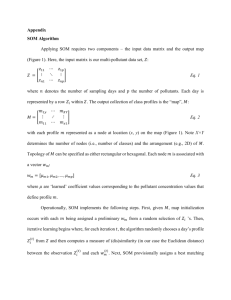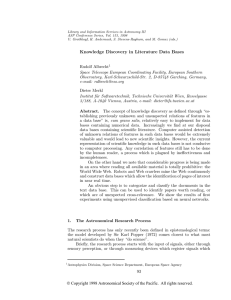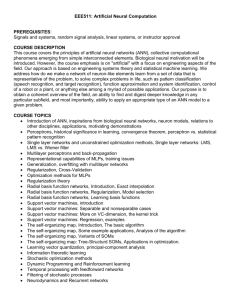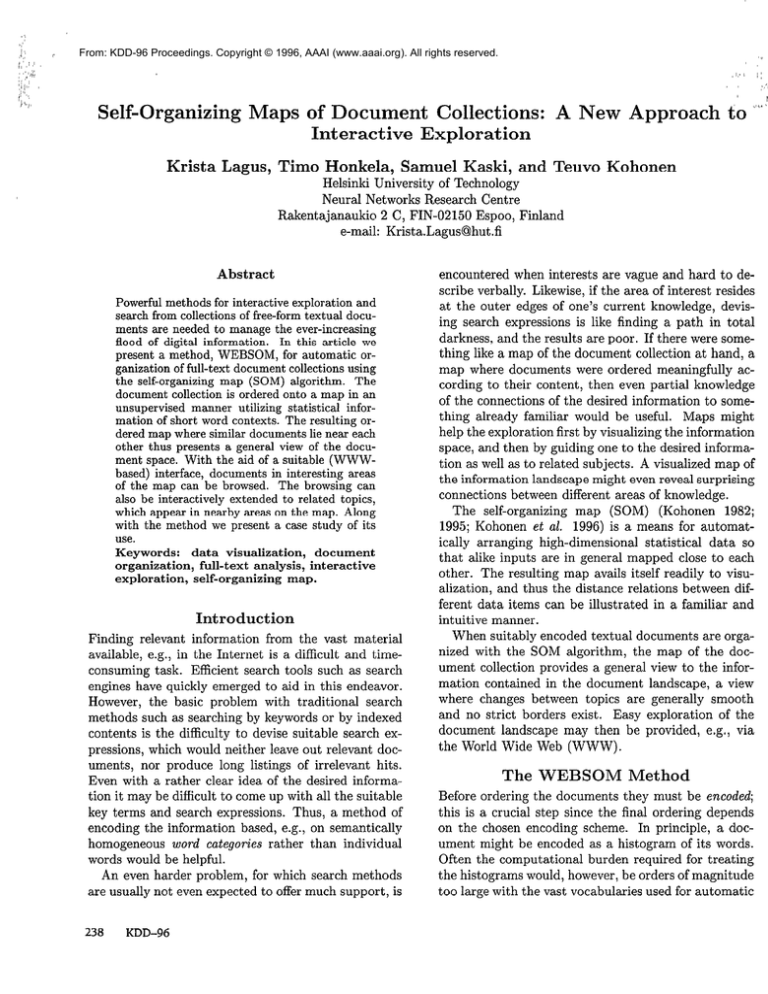
From: KDD-96 Proceedings. Copyright © 1996, AAAI (www.aaai.org). All rights reserved.
Self-Organizing
Krista
Maps
of Document
Collections:
Interactive
Exploration
Lagus, Timo
Honkela,
Samuel
Kaski,
A New Approach
and Teuvo
to “‘*
Kohonen
Helsinki University
of Technology
Neural Networks Research Centre
Rakentajanaukio 2 C, FIN-02150 Espoo, Finland
e-mail: Krista.Lagus@hut.fi
Abstract
Powerful methods for interactive exploration and
search from collections of free-form textual documents are needed to manage the ever-increasing
flood of digital information.
In this article we
present a method, WEBSOM, for automatic organization of full-text document collections using
the self-organizing map (SOM) algorithm.
The
document collection is ordered onto a map in an
unsupervised manner utilizing statistical information of short word contexts. The resulting ordered map where similar documents lie near each
other thus presents a general view of the document space. With the aid of a suitable (WWWbased) interface, documents in interesting areas
of the map can be browsed. The browsing can
also be interactively extended to related topics,
which appear in nearby areas on the map. Along
with the method we present a case study of its
use.
Keywords:
data visualization,
document
organization,
full-text
analysis, interactive
exploration,
self-organizing
map.
Introduction
Finding relevant information from the vast material
available, e.g., in the Internet is a difficult and timeconsuming task. Efficient search tools such as search
engines have quickly emerged to aid in this endeavor.
However, the basic problem with traditional search
methods such as searching by keywords or by indexed
contents is the difficulty to devise suitable search expressions, which would neither leave out relevant documents, nor produce long listings of irrelevant hits.
Even with a rather clear idea of the desired information it may be difficult
to come up with all the suitable
key terms and search expressions. Thus, a method of
encoding the information based, e.g., on semantically
homogeneous word categories rather than individual
words would be helpful.
An even harder problem, for which search methods
are usually not even expected to offer much support, is
238
KDD-96
encountered when interests are vague and hard to describe verbally. Likewise, if the area of interest resides
at the outer edges of one’s current knowledge, devising search expressions is like finding a path in total
darkness, and the results are poor. If there were something like a map of the document collection at hand, a
map where documents were ordered meaningfully according
to their
content,
then even partial
knowledge
of the connections of the desired information to something already familiar would be useful. Maps might
help the exploration first by visualizing the information
space, and then by guiding one to the desired information as well as to related subjects. A visualized map of
the information landscape might even reveal surprising
connections between different areas of knowledge.
The self-organizing map (SOM) (Kohonen 1982;
1995; Kohonen et al. 1996) is a means for automatically arranging high-dimensional statistical data so
that alike inputs are in general mapped close to each
other. The resulting map avails itself readily to visualization, and thus the distance relations between different data items can be illustrated in a familiar and
intuitive manner.
When suitably encoded textual documents are organized with the SOM algorithm, the map of the document collection provides a general view to the information contained in the document landscape, a view
where changes between topics are generally smooth
and no strict borders exist. Easy exploration of the
document landscape may then be provided, e.g., via
the World Wide Web (WWW).
The WEBSOM
Method
Before ordering the documents they must be encoded;
this is a crucial step since the final ordering depends
on the chosen encoding scheme. In principle, a document might be encoded as a histogram of its words.
Often the computational burden required for treating
the histograms would, however, be orders of magnitude
too large with the vast vocabularies used for automatic
full-text analysis. An additional problem with the
word histograms is that the discrete, symbolic words
as such retain no information of their relatedness. Synonyms appear to be as distant as any unrelated words,
although in a useful full-text analysis method similar
words shouid obviously be encoded simiiariy.
Since it is not currently feasible to incorporate references to real-life experience of word meanings to a
text analysis method, the remaining alternative is to
use the statistics of the contexts of words to provide
information on their relatedness. It has turned out
that the size of the word histograms can be reduced to
a fraction with the so-called self-organizing semantic
maps (Ritter & Kohonen 1989). At the same time, by
virtue of the organizing power of the SOM, the semantic
a_- Gmilaritv
L ______
-__AJ of
-. the
_‘..- w&s
C~II lx
t&n
bta
account.
in
encoding the documents.
Preprocessing
Text
Before applying the SOM to a document collection (in
this case 8800 articles from a Usenet newsgroup, with
a total of 2 000 000 words) we automatically removed
some non-textual information from the documents. In
the remaining text, numerical expressions and several
kinds of common code words were categorized with
heuristic rules into a few classes of special symbols.
To reduce the computational ioad the words that occurred only a few times (in this experiment less than
50 times) in the whole data base were neglected and
treated as empty slots.
In order to emphasize the subject matters of the articles and to reduce variations caused by the different
discussion styles, which were not of interest in this experiment, a group of common words that were not supposed to discriminate any discussion topics were discarded from the vocabulary. In the actual experiment
we removed 1000 common words from the vocabulary
of 3300 words that remained after discarding the rarest
words.
The SOM
Algorithm
To provide a general understanding of what the selforganizing map is and why it is suitable for ordering
large collections of text documents, the following expedition of thought may be helpful.
Consider an information processing system, such as
a brain area, which must learn to carry out different
toalra
ur.w.nru,near-h
~..J,c.‘Inf
“I thorn
“ll”Ill
wnll
aaa,,mo that
YU” ,,a
U” cu”“U1AII..
“LAW”the
“ll... amtmn
“J “YYIIA
.I UI1. T,nt
may assign different tasks to different sub-units that
are able to learn from what they do. Each new task is
given to the unit that can best complete the task. Since
the units learn, and since they receive tasks that they
can do well, they become even more competent in those
tasks. This is a model of specialization by competitive
learning. Furthermore, if the units are interconnected
in such a way that also the (predefined) neighbors of
the unit carrying out a task are allowed to learn some
of the task, the system also slowly becomes ordered:
nearby units have similar abilities, and the abilities
change siowiy and smoothiy over the whoie system.
This is the general principle of the self-organizing map
(SOM). The system is called a map and the task is to
imitate, i.e., represent the input. The representations
become ordered according to their similarity relations
in an unsupervised learning process. This property
makes the SOM useful for organizing large collections
of data in general, including document collections.
In the simplest kinds of SOMs the map consists of
a regular grid of units, and the task is to represent
statistical data, described by vectors z E ?lP. Each
map unit i contains a model vector rni E W, and the
model vectors are used for representing the data. In the
learning process the model vectors change gradually
so that finally the map forms an ordered non-linear
regression of the model vectors into the data space.
At each step t of the learning process, a data sample
z(t) is presented to the units. The node c that best
represents the input is then searched for using, e.g.,
the Euclidean distance to define the quality of the representation: 11~- rncll = mini{lla: - m,ll}. Next, the
unit c as weii as the neighboring units iearn to represent the data sample more accurately. The model
vector of unit i is updated according to the following
learning rule:
m,(t + 1) = m%(t) + h,i(t)[x(t)
- mi(t)].
(1)
Here h,, is a “smearing” or neighborhood function expressing how much the unit i is updated when unit
c is the winner. The neighborhood function typically
is a symmetric, monotonically decreasing function of
the distance of units i and c on the map grid. During repeated application of (1) with different inputs,
model vectors of neighboring map units become gradually similar because of the neighborhood function hci,
eventually leading to global ordering of the model vectors.
The Word
Category
Map
The word category map that is used for document encoding is organized according to word similarities, measured by the similarity of the contexts of the words.
fklrPntllallv
vv’.‘YYyYu’y”J
relnfd
wgr&j
-v.wYYu
tend
to fzi]
ip*t,Q the
&$gme
or neighboring map nodes. Nodes may thus be viewed
as word categories. The ordering is formed by the SOM
algorithm based on the average short contexts of the
words (Ritter & Kohonen 1989).
In our experiment, the word contexts were of length
three, and consisted of one preceding and one following
Spatial, Text, &ZMultimedia
239
word in addition to the word that was being encoded.
The ith word in the sequence of words is represented by
an n-dimensional (here 90) real vector zi with random
number components. The averaged context vector of
a word, marked by w, may be expressed as follows:
where E denotes the conditional average over the whole
text corpus, and E is a small constant, here 0.2. Now
the real-valued vectors X(w), in our experiment of dimension 270, constitute the input vectors given to the
word category map. During the training of the map,
the averaged context vectors X(w) were used as input.
After the map has self-organized, each map node
corresponds to a set of input vectors that are close
to each other in the input space. A map node may
thus be expected to approximate a set of similar inputs, here averaged word contexts. All the inputs for
which a node is the best match are associated with the
node. The result is a labeling of the map with words,
where each node on the map is associated with all the
inputs X(w) for which the node is the closest representative. The word in the middle of the context, that
is, the word corresponding to the w part of the context vector, was used as a label of the node. In this
method a unit may become labeled by several symbols,
often synonymic or describing alternative or opposing
positions or characteristics. Examples of map nodes
are illustrated in Fig. 1. Interrelated words that have
similar contexts tend to appear near each other on the
map.
The Document
Map
With the aid of the word category map the documents
can be encoded as word category histograms. Very
closely related words (that are in the same category
on the map) then contribute identically to the code
formed for a document.
It would also be advantageous if words in similar categories contributed similarly to the codes of the documents. This is indeed possible to achieve since the
word category map is ordered. The relations of the
categories are reflected in their distances on the map.
Therefore, the contributions of nearby categories can
be made similar by smoothing the histogram on the
word category map, whereby the encoding becomes less
influenced by the choices of words made by the authors
of the documents. A moderately narrow (e.g., diminishing to the half of the maximum value between two
neighboring map units) Gaussian function was found
to be a suitable smoothing kernel in our recent experiments.
240
KDD-96
r
Figure 1: Sample categories illustrated on a word category map. Similar words tend to occur in the same
or nearby map nodes, forming “‘word categories”. The
map was computed using a massively parallel neurocomputer CNAPS, and fine-tuned with the SOMPAK
software (Kohonen et al. 1996).
A representative sample of the encoded documents is
presented as input to the SOM, which organizes them
by unsupervised learning. After the map is formed,
also documents that were not used in the learning may
be automatically positioned onto the map.
When the learning process is complete the density of
the documents in the document space can be visualized
as shades of gray on the document map, to illustrate
the relations of different map locations (see Fig. 3).
Previous Work
with the SOM
on Organizing
Documents
Several studies have been published on SOMs that map
words into grammatical and semantic categories (e.g.,
by Honkela, Pulkki, & Kohonen 1995; Miikkulainen
1993; Ritter & Kohonen 1989; 1990; and Scholtes
1993). The SOM has also been utilized previously to
form a small map based on the titles of scientific documents (Lin, Soergel, & Marchionini 1991). Scholtes
has applied the SOM extensively in natural language
processing, e.g., developed a neural filter along with
a neural interest map for information retrieval (1992a;
1992b). Merkl (1993; Merkl, Tjoa, & Kappel1994) has
used the SOM to cluster textual descriptions of software library components. Quite recently we have also
been informed of an approach studied in the University
of Arizona AI Lab for organizing WWW-pages.
Exploring
Document
Maps
We have designed a browsing environment which utiiizes the order of the document map. The document
collection may be explored with any graphical WWW
browser.
Example: Documents
Newsgroup sci.lang
from the Usenet
To ensure that the WEBSOM method works in realistic applications, we performed a case study with
material that is difficult enough from the textual analysis point of view. We organized a map with a collection of 8800 full-text articles that appeared in the
Usenet newsgroup “sci.lang” during the latter half of
1995, containing approximately a total of 2 000 000
words. The articles are colloquial, mostly rather carelessly written short documents that contain little topical information to organize them properly. Furthermore, spelling errors are not uncommon. Currently (1
May) over 13 000 articles have been organized by the
map.
Multiple
Method
Applications
of the WEBSOM
The WEBSOM method is readily applicable to any
kind of a collection of textual documents. It is especially suitable for exploration tasks in which the users
either do not know the domain very well, or they have
only a limited or vague idea of the contents of the fulltext database being examined. With the WEBSOM,
the documents are ordered meaningfully according to
their contents, and thus related documents are located
pAear mrh
v1w-* nt.hm
-“.^.,..
Mnm
alan hdn
*.-“,yu U.YV
..y.y the
“..V cwnlnratinn
.,~.y’“.~“.“..
hv
airrVJ 8.”
ing an overall view of what the document space looks
like.
In the World Wide Web, one target of application
for the WEBSOM is the organization of home pages instead of newsgroup articles. Also electronic mail messages can be automatically positioned on a suitable
map organized according to personal interests. Relevant areas and single nodes on the map could be used
as “mailboxes” into which specified information is automatically gathered.
The method can also be used to organize official letters, personal files, library collections, and corporate
full-text databases. Especially administrative or legal
documents may be difficult to locate by traditional information retrieval methods, because of the specialized
terminologies used. The category-based and redundantly encoded approach of the WEBSOM is expected
to alleviate the terminology problem.
Conclusions
The document maps may be explored via a point-andclick interface: the user may zoom in on any map area
by clicking the map image to view the underlying document space in more detail. Fig. 2 presents the four
different view levels that one encounters when exploring the material. The view of the whole map (part 1
of Fig. 2) offers a general overview on the whole document collection. The display may be focused to a
zoomed map view, deeper to a specific node, and finaliy to a singie document.
In a typical session, the user might start from the
overall map view, and proceed to examine further a
specific area, perhaps later gradually wandering to
close-by areas containing related information.
Clickable arrow images are provided for moving around on
the map. After finding a particularly interesting node,
one may use it as a “trap” or “document bin” which
can be checked regularly to see if new interesting articles have arrived. An exploration example of the
In this work we have presented a novel method for
organizing collections of documents into maps, and
a browsing interface for exploring the maps. The
method, called the WEBSOM, performs a completely
automatic and unsupervised full-text analysis of the
document set using self-organizing maps. The result of
the analysis, an ordered map of the document space,
visualizes the similarity relations of the subject matters of the documents; they are reflected as distance
relations on the document map.
The present version of the WEBSOM interface has
the basic functionality needed for exploring the document collection: Moving on the document map, zooming in on the map and viewing the contents of the
nodes. Many different directions for enhancing the interface are possible. For example, ideal starting points
for exploration could be provided by finding the position where a user-specified document would fall on
the map. The WEBSOM (Honkela et al. 1996) tool
is already available for exploring collections of Usenet
“sri land’
“““‘““b
?lPTI,Q
..u
1. ” artiPlna
w. “.“.UU.
.man
..“y
ia
.” fhnwn
“I.“....
in
1.. Vim
A .a. -2
V.
Spatial, Text, Q Multimedia
241
References
Honkela, T.; Kaski, S.; Lagus, K.; and Kohonen, T. 1996. Newsgroup exploration with WEBSOM method and browsing interface. Technical Report A_.?& ---.L
Helsinki
T,ah-___. -_.-_lJ of Technnlnm.
--- ____---oJ,
--_
-_--._ TJnivarsitv
oratory of Computer and Information Science, Espoo.
WEBSOM home page (1996) available at
http://websom.hut.fi/websom/.
Honkela, T.; Pulkki, V.; and Kohonen, T. 1995. Contextual relations of words in Grimm tales analyzed
by self-organizing map. In Fogelman-Soul%, F., and
Gallinari, P., eds., Proceedings of the International
Conference on Artificial Neural Networks, ICANN95, volume 2, 3-7. Paris: EC2 et Cie.
Scholtes, J. C. 1991a. Kohonen feature maps in fulltext data bases: A case study of the 1987 Pravda.
In Proc. Informatiewetenschap 1991, Nijmegen, 203220. Nijmegen, Netherlands: STINFON.
information retrieval problem. In Proceedings of the
International Joint Conference on Neural Networks,
IJCNN’SI, 18-21. Piscataway, NJ: IEEE Service Center.
Scholtes, J. C. 1993. Neural Networks in Natural Language Processzng and Information Retrieval. Ph.D.
Dissertation, Universiteit van Amsterdam, Amsterdam, Netherlands.
Kohonen, T.; Hynninen, J.; Kangas, J.; and Laaksonen, J. 1996. SOM-PAK: The self-organizing map
program package. Technical Report A31, Helsinki
University of Technology, Laboratory of Computer
and Information Science, Espoo.
Kohonen, T. 1982. Self-organized formation of topologically correct feature maps. BioEogicaZ Cybernetics
43:59-69.
Kohonen, T.
Springer.
1995. Self-Organizing
Maps.
Berlin:
Lin, X.; Soergel, D.; and Marchionini, G. 1991.
A self-organizing semantic map for information retrieval. In Proceedings of the 14th Annual International ACM/SIGIR
Conference on Research d Development in Information Retrieval. 262-269.
Merkl, D.; Tjoa, A. M.; and Kappel, G. 1994. A
self-organizing map that learns the semantic similarity of reusable software components. In Proceedings
of the 5th Australian Conference on Neural Networks,
ACNN’G4. 13-16.
Merkl, D. 1993. Structuring software for reuse - the
case of self-organizing maps. In Proceedings of the
International Joint Conference on Neural Networks,
IJCNN-9%Nagoya, volume III, 2468-2471. Piscataway, NJ: IEEE Service Center.
Miikkulainen, R. 1993. Subsymbolic Natural Language
Processing: An Integrated Model of Scripts, Lexicon,
and Memory. Cambridge, MA: MIT Press.
Ritter, H.: and Kohonen: T. 1989. Self-organizing
semantic maps. BiologicaE Cybernetics 61:241-254.
Ritter, H., and Kohonen, T. 1990. Learning ‘semantotopic maps’ from context. In Proceedings of the
International Joint Conference on Neural Networks,
IJCNN-SO- Washington-DC, volume I, 23-26. Hillsdale, NJ: Lawrence Erlbaum.
Spatial, Text, Q Multimedia
243


